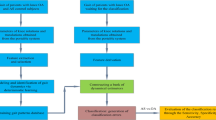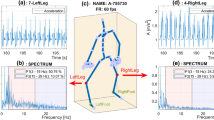Abstract
This study concentrates on dynamical motion characteristics of knees during treadmill walking, and describes the application of kernel principal component analysis and deterministic learning theory to the detection of abnormal gait dynamics induced by knee pathologies. First, twelve-dimensional knee joint rotation and translation parameters are measured by a marker-based motion analysis system during treadmill walking. Second, the dimension of the gait parameter signal is reduced based on kernel principal component analysis. Third, gait dynamics underlying time-varying gait parameter signal is captured by using localized radial basis function neural networks through deterministic learning mechanism. This kind of dynamics information represents the frame-to-frame temporal change of kinematics and kinetics modifications during treadmill walking, which is shown to be sensitive to the variance during knee pathologies. Gait patterns are represented as the gait dynamics underlying time-varying gait parameters. The training patters under different knee pathologies further constitute a uniform training dataset, containing all kinds of gait dynamics under different knee pathologies. By comparing the training patterns with a test knee gait pattern to be recognized, a set of recognition errors are generated. The average \(L_1\) norms of the errors are taken as the classification measure between the dynamics of the training gait patterns and the dynamics of the test pattern. A rapid recognition scheme can be achieved according to the smallest error principle. Experimental results show that encouraging recognition accuracy can be achieved. The proposed method is sensitive for the detection of knee pathologies and is capable of discharge of patients without knee pathologies.





Similar content being viewed by others
References
Armand S, Watelain E, Mercier M, Lensel G, Lepoutre F (2007) Linking clinical measurements and kinematic gait patterns of toe-walking using fuzzy decision trees. Gait Posture 25:475–484
Baker R (2006) Gait analysis methods in rehabilitation. J Neuroeng Rehabil 3(1):4
Barton G, Lisboa P, Lees A, Attfield S (2007) Gait quality assessment using selforganising artificial neural networks. Gait Posture 25:374–379
Barton G, Hawken M, Scott M, Schwartz M (2012) Movement deviation profile: a measure of distance from normality using a self-organizing neural network. Hum Mov Sci 31:284–294
Begg R, Palaniswami M, Owen B (2005) Support vector machines for automated gait classification. IEEE Trans Biomed Eng 1:52–65
Deng M, Wang C, Chen Q (2016) Human gait recognition based on deterministic learning through multiple views fusion. Pattern Recogn Lett 78:56–63
Deng M, Wang C, Cheng F, Zeng W (2017) Fusion of spatial-temporal and kinematic features for gait recognition with deterministic learning. Pattern Recogn 67:186–200
Elbaz A, Mor A, Segal G, Debi R, Shazar N, Herman A (2014) Novel classification of knee osteoarthritis severity based on spatiotemporal gait analysis. Osteoarthr Cartil 22:457–463
Fuller D, Keenan M, Esquenazi A, Whyte J, Mayer N, FidlerSheppard R (2002) The impact of instrumented gait analysis on surgical planning: treatment of spastic equinovarus deformity of the foot and ankle. Foot Ankle Int. 23:738–743
Jolliffe I (1986) Principal component analysis. Springer, New York
Köktaş N, Yalabik N, Yavuzer G, Duin R (2010) A multi-classifier for grading knee osteoarthritis using gait analysis. Pattern Recogn Lett 31:898–904
Lai D, Begg R, Palaniswami M (2009) Computational intelligence in gait research: a perspective on current applications and future challenges. IEEE Trans Inf Technol Biomed 13:687–702
Lakany H (2008) Extracting a diagnostic gait signature. Pattern Recognit 41:1627–1637
Patrick J, Keenan M (2007) Gait analysis to assist walking after stroke. Lancet 369:256–257
Robbins S, Wilson J, Rutherford D (2013) Reliability of principal components and discrete parameters of knee angle and moment gait waveforms in individuals with moderate knee osteoarthritis. Gait Posture 38:421–427
Robinson JC (1998) All possible chaotic dynamics can be approximated in three dimensions. Nonlinearity 11(3):529–545
Sant’Anna A, Salarian N (2011) A new measure of movement symmetry in early Parkinson’s disease patients using symbolic processing of inertial sensor data. IEEE Trans Biomed Eng 58:2127–2135
Schwartz M, Rozumalski A (2008) The gait deviation index: a new comprehensive index of gait pathology. Gait Posture 28:351–357
Simon SR (2004) Quantification of human motion: gait analysis–benefits and limitations to its application to clinical problems. J Biomech 37:1869–1880
Skaggs D, Rethlefsen S, Kay R, Dennis S, Reynolds R, Tolo V (2000) Variability in gait analysis interpretation. J Pediatr Orthop 20:759–764
Wang C, Hill DJ (2007) Deterministic learning and rapid dynamical pattern recognition. IEEE Trans Neural Netw 18:617–630
Wang C, Hill DJ (2009) Deterministic learning theory for identification, recognition and control. CRC Press, Boca Raton
Whittle M (1996) Clinical gait analysis: a review. Hum Mov Sci 15:369–387
Wikstrom J, Georgoulas G, Moutsopoulos T, Seferiadis A (2014) Intelligent data analysis of instrumented gait data in stroke patients. Comput Biol Med 51:61–72
Wren T, Gorton G (2011) Efficacy of clinical gait analysis: a systematic review. Gait Posture 34:149–153
Zeng W, Wang C (2015) Classification of neurodegenerative diseases using gait dynamics via deterministic learning. Inf Sci 317:246–258
Zeng W, Wang C, Yang F (2014) Silhouette-based gait recognition via deterministic learning. Pattern Recogn 47:3568–3584
Zhang Y, Yao Z, Wang S, Huang W, Ma L, Huang H, Xia H (2015) Motion analysis of Chinese normal knees during gait based on a novel portable system. Gait & Posture 41:763–768
Acknowledgements
This work was supported by the National R&D Program for Major Research Instruments (Grant no. 61527811), by the National Natural Science Foundation of China (Grant nos. 61374119, 61473121, 61573112), by key research grant for national fitness from General Administration of Sports of China (Grant no. 2015B043), by the Guangdong Natural Science Foundation (Grant no. 2014A030312005), by the 111 Project (Grant no. B12018), by the Science and Technology New Star of Zhujiang, by the Fundamental Research Funds for the Central Universities. The authors would like to thank Professor Jie Huang in the Department of Mechanical and Automation Engineering, The Chinese University of Hong Kong for his continued supports and great trust.
Author information
Authors and Affiliations
Corresponding author
Additional information
Publisher’s Note
Springer Nature remains neutral with regard to jurisdictional claims in published maps and institutional affiliations.
Rights and permissions
About this article
Cite this article
Deng, M., Feng, X., Zeng, W. et al. Recognizing knee pathologies by using gait dynamics via kernel principal component analysis and deterministic learning theory. J Ambient Intell Human Comput 14, 15535–15543 (2023). https://doi.org/10.1007/s12652-018-0890-4
Received:
Accepted:
Published:
Issue Date:
DOI: https://doi.org/10.1007/s12652-018-0890-4




